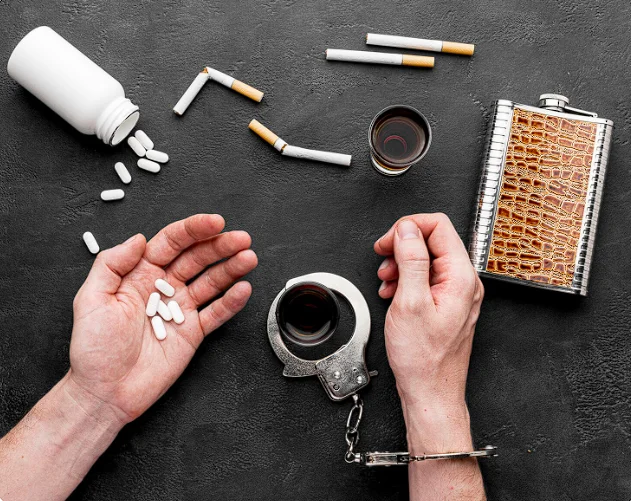Cognitive Behavioral Therapy (CBT) has proven to be a highly effective treatment for addiction. It helps individuals understand and change their behavior patterns, particularly when it comes to managing cravings and triggers.
If you’re struggling with addiction, CBT offers a structured approach to identify harmful thought patterns and replace them with healthier, more productive ones. This article explores how CBT for addiction works, highlighting practical techniques that can help you manage cravings and triggers effectively.
Understanding CBT for Addiction
Addiction is a complex condition that often involves both psychological and physical components. Whether it’s substance abuse, alcohol dependence, or behavioral addictions, the road to recovery can be long and challenging. One of the most widely recognized therapeutic approaches for addiction is Cognitive Behavioral Therapy (CBT).
CBT is grounded in the idea that our thoughts, feelings, and behaviors are interconnected. By identifying and changing negative thought patterns, CBT helps individuals break the cycle of addiction.
The therapy equips people with tools to manage cravings, resist triggers, and reduce the risk of relapse. Through various techniques, CBT enables individuals to understand their behavior, confront harmful thoughts, and develop healthier coping mechanisms for lasting recovery.
What is CBT for Addiction?
CBT for addiction focuses on addressing the cognitive and behavioral aspects of addiction. It helps individuals recognize the unhealthy thoughts and beliefs that contribute to addictive behavior and provides practical strategies to replace them with more constructive ones.
CBT encourages individuals to develop a deeper understanding of their triggers and teaches skills to cope with situations that may lead to relapse.
Key CBT Techniques for Addiction Recovery
There are several techniques used in CBT therapy for addiction to help individuals overcome their addictive behaviors. These methods are designed to modify both thinking patterns and behaviors, making them highly effective in treating addiction.
Identifying and Challenging Negative Thought Patterns
One of the core principles of CBT is identifying and challenging negative thought patterns. Addiction often stems from distorted thoughts, such as rationalizing the need for the substance or behavior. For example, someone might think, “I deserve this drink because I’ve had a stressful day.” This type of thinking reinforces the addiction.
CBT helps individuals recognize these cognitive distortions and replace them with healthier, more realistic thoughts. By learning to challenge these thoughts, individuals can break free from the cycle of addiction and prevent relapse.
Cognitive Restructuring for Addiction
Cognitive restructuring is a technique used in CBT for addiction to help individuals change maladaptive thinking patterns. This process involves identifying irrational beliefs and replacing them with more balanced and realistic thoughts.
For instance, if someone believes, “I’ll never be able to control my cravings,” CBT helps challenge this thought by highlighting past instances where they’ve successfully managed cravings. This can boost their confidence and motivation to continue working on their recovery.
Behavioral Activation
Behavioral activation is another technique used in CBT activities for addiction. It involves encouraging individuals to engage in positive activities that counteract the urge to engage in addictive behaviors.
By participating in healthy, enjoyable activities, individuals can distract themselves from cravings and triggers. Behavioral activation promotes a sense of accomplishment and well-being, which helps to reduce the risk of relapse.

Managing Cravings and Triggers with CBT
Understanding and managing cravings and triggers are key components of CBT and addiction recovery. Cravings are intense desires to engage in addictive behavior, while triggers are situations or emotions that prompt these cravings.
Understanding Triggers and Cravings
Triggers can be internal (such as stress or anxiety) or external (like being around certain people or places associated with substance use). Cravings often follow these triggers, making it important to identify and understand them. Through CBT, individuals can become more aware of their personal triggers and learn to address them effectively.
Techniques for Managing Cravings
CBT offers several techniques for managing cravings. Some of the most effective methods include:
- Cognitive distraction: Focusing on something else when cravings arise, such as engaging in a hobby or calling a friend.
- Mindfulness: Becoming more aware of the craving without acting on it, allowing it to pass naturally without judgment.
- Delayed response: When a craving occurs, individuals may learn to delay responding to it by distracting themselves for a set period of time, allowing the craving to subside.
These techniques help individuals gain control over their cravings, making it easier to resist the urge to give in to addictive behaviors.
Exposure Therapy and Desensitization
Exposure therapy is another powerful technique used in CBT therapy for addiction. It involves gradually exposing individuals to situations that trigger cravings, starting with less intense situations and slowly increasing exposure. This process helps individuals become desensitized to their triggers over time, reducing the emotional and physiological response to them.
For example, someone recovering from alcohol addiction might gradually spend time in social settings where alcohol is present, learning how to manage cravings and resist the urge to drink. Over time, exposure therapy helps reduce the power of triggers and cravings.
Building Resilience and Preventing Relapse with CBT
A critical aspect of CBT for addiction is building resilience and preventing relapse. By developing coping skills and a strong sense of self-efficacy, individuals are better equipped to handle the challenges they face in recovery.
Developing Coping Skills
CBT teaches individuals coping strategies to deal with stress, negative emotions, and life’s challenges without resorting to addictive behaviors. These skills include problem-solving techniques, relaxation exercises, and assertiveness training, which help individuals manage stress in healthier ways.
Relapse Prevention Strategies
A key component of CBT is relapse prevention. This involves identifying high-risk situations and developing strategies to avoid or manage them. For example, if someone is at risk of relapsing due to stress at work, CBT helps them identify stress management techniques to cope with these situations without turning to their addiction.
By learning to recognize early signs of relapse and using their coping strategies, individuals can significantly reduce their risk of returning to old behaviors.
Enhancing Self-Efficacy and Motivation
Self-efficacy refers to an individual’s belief in their ability to succeed. In CBT and addiction recovery, enhancing self-efficacy is crucial to long-term success. Through positive reinforcement and goal-setting, CBT helps individuals build confidence in their ability to resist cravings and maintain their recovery.
Integrating CBT with Other Treatments for Comprehensive Recovery
While CBT for addiction is highly effective, it is often used in combination with other treatments for a more comprehensive approach to recovery. Combining CBT with other therapies can provide a well-rounded treatment plan tailored to an individual’s unique needs.
Combining CBT with Medication
For some individuals, CBT and addiction treatments work best when combined with medication. Medications may be prescribed to manage withdrawal symptoms, reduce cravings, or address underlying mental health conditions, such as depression or anxiety. When used together, CBT and medication can enhance the effectiveness of treatment and improve long-term recovery outcomes.Group Therapy and
Support Systems
In addition to individual CBT, group therapy and support systems play a significant role in addiction recovery. Group therapy provides individuals with a sense of community and support, while also offering opportunities to learn from others who are facing similar challenges. Support groups, such as 12-step programs, can complement CBT by providing additional emotional support and guidance throughout the recovery process.

How to Get Started with CBT for Addiction
If you’re considering CBT for addiction, the first step is to find a qualified therapist who specializes in addiction recovery. A trained therapist can guide you through the process, provide support, and help you develop personalized strategies to manage cravings and triggers.
Finding a Qualified CBT Therapist
When looking for a therapist, ensure they have experience in CBT and addiction treatment. Many therapists offer free consultations to help you determine if their approach aligns with your needs.
What to Expect During CBT Sessions
During your sessions, the therapist will help you identify the thoughts and behaviors that contribute to your addiction. You will work together to develop strategies to address cravings and triggers, challenge negative thought patterns, and improve coping skills.
Committing to Long-Term Recovery
CBT for addiction is a long-term commitment. While progress can be seen early on, lasting recovery requires continuous effort and dedication. Regular sessions and ongoing practice of the techniques learned in therapy are essential for maintaining progress and preventing relapse.
Key Steps to Getting Started with CBT for Addiction:
- Find a qualified CBT therapist who specializes in addiction.
- Commit to attending regular therapy sessions and engaging in the process.
- Practice the techniques you learn in therapy between sessions to reinforce your progress.
- Seek support from others, whether through group therapy or support networks, to stay motivated.
Conclusion: Taking the First Step Toward Recovery
If you or someone you know is struggling with addiction, CBT for addiction offers a practical and effective approach to recovery. By understanding how CBT works, learning to manage cravings and triggers, and committing to long-term recovery, individuals can achieve lasting change.
If you’re ready to take the first step, reach out to a therapist or mental health provider who specializes in addiction and CBT therapy for addiction to begin your path to a healthier, addiction-free life.
